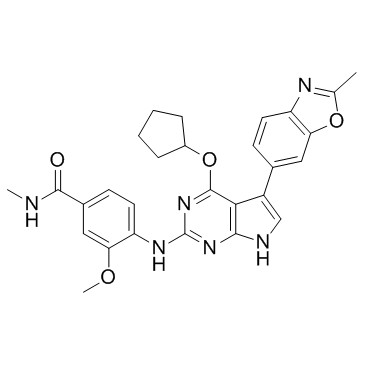| Cas No.: | 1618658-88-0 |
| Chemical Name: | 4-((4-(cyclopentyloxy)-5-(2-methylbenzo[d]oxazol-6-yl)-7H-pyrrolo-[2,3-d]pyrimidin-2-yl)amino)-3-methoxy-N-methylbenzamide |
| Synonyms: | CC671;CC 671 |
| SMILES: | CC1=NC2=C(O1)C=C(C=C2)C3=CNC4=C3C(=NC(=N4)NC5=C(C=C(C=C5)C(=O)NC)OC)OC6CCCC6 |
| Formula: | C28H28N6O4 |
| M.Wt: | 512.57 |
| Purity: | >98% |
| Sotrage: | 2 years -20°C Powder, 2 weeks 4°C in DMSO, 6 months -80°C in DMSO |
| Description: | CC-671 is a dual TTK protein kinase/CDC2-like kinase (CLK2) inhibitor with IC50s of 0.005 and 0.006 μM for TTK and CLK2, respectively. |
| Target: | Clk2:0.006 μM (IC50) |
| In Vivo: | CC-671 (compound 23) demonstrates significant tumor growth inhibition (TGI) ((vehicle -treated/vehicle) ×100%) of 71% at both 10 and 20 mg/kg on a every 3 days (q3d) dosing schedule. The body weight loss (BWL) in the CC-671 treated group (20 mg/kg ) is higher than in the 10 mg/kg group (17% vs 5%)[1]. |
| In Vitro: | CC-671 (compound 23) is a dual TTK protein kinase/CDC2-like kinase (CLK2) inhibitor with IC50s of 0.005 and 0.006 μM for TTK and CLK2, respectively. HCT-116 cell lysates treated with CC-671 at 3 μM for 1 h demonstrates that only four kinases show cellular binding of 75% or more including CLK2, CAMKK2, PIP4K22, and JNK[1]. |
| Kinase Assay: | The kinase selectivity profile of CC-671 (compound 23) is assessed. The screen is conducted with the concentration of CC-671 held constant at 3 μM. The TTK binding affinity is measured using the kinase binding assays. The kinase binding assays are based on the binding and displacement of a proprietary, Alexa Fluor 647-labeled, ATP-competitive kinase inhibitor scaffold[1]. |
| Animal Administration: | Female SCID mice are inoculated subcutaneously with 5×106 Cal-51 cells. Mice with tumors of approximately 125 mm3 are randomized and treated intravenously at various doses and schedules of CC-671 (compound 23) (n=8 to10/group). Tumors are measured twice a week for the duration of the study. The long and short axes of each tumor are measured using a digital caliper in millimeters and the tumor volumes are calculated[1]. |
| References: | [1]. Riggs JR, et al. The Discovery of a Dual TTK Protein Kinase/CDC2-Like Kinase (CLK2) Inhibitor for the Treatmentof Triple Negative Breast Cancer Initiated from a Phenotypic Screen. J Med Chem. 2017 Nov 9;60(21):8989-9002. |

 To enhance service speed and avoid tariff delays, we've opened a US warehouse. All US orders ship directly from our US facility.
To enhance service speed and avoid tariff delays, we've opened a US warehouse. All US orders ship directly from our US facility.




















